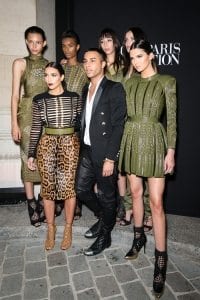Previously considered to be a very high fashion, selectively placed, and an exclusive brand, Balmain has broken free of traditional branding. Balmain’s recently appointed creative director, Olivier Rousteing, is the reason behind one of today’s most talked about fashion lines. Rousteing’s vision back in 2011 was to launch a digital revolution for the brand by shying away from traditional marketing tactics, such as exclusive magazine placement, and transitioned to honing in on social media to reach a wider audience base. In just a short four years, the brand has transformed from a Parisian-esque style, and exclusive fashion line, to a democratic and international powerhouse.
The late president of Balmain, Alain Hivelin, always sought out to make the brand international by creating a global, strong, and powerful empire. The direction was a continuance of Founder, Pierre Balmain’s vision. When Olivier Rousteing was brought on, his vision was simple: “communicate through social media while keeping the DNA of Balmain”.
Although we are not discounting Rousteing’s direction, Balmain’s chairman and majority owner, Alain Hivelin’s late 2014 passing, may have actually been the best thing for the brand. In 2006, their previous creative director, Christophe Decarnin, originally tried transforming the fashion line’s design from stuffy-couture to rock-chic; however, potential customers never bought into the line’s extravagant pricing. As a result, sales began to drop. Upper management was never able to see eye to eye with Decarnin’s direction and so the designer could never fully live out his vision. The brand lacked solidarity and needed to start from scratch. Timing could never have been better for Rousteing. Thankfully, his point of view became the right point of view.
During an interview with Rousteing at “Inside Fashion,” he mentions the difference between him and Christophe. “He was more into street wear, where as I am more into glamor. He was more into Kate Moss, I am more into Rihanna, he was more into rock and roll, I am more into pop and hip hop, it is just different vibes, different generations, a different age.” The designer goes onto say, “Pierre Balmain always believed in really strong women…he worked a lot on the tailoring and also the couture aspect, the embroidery and the craftsmanship. This is an aesthetic I have always loved.” And so that is what Rousteing mimicked.
Rousteing’s goal of capturing a wider audience became a reality when he created the ‘Balmain Army.’ The group of brand ambassadors included pop and hip-hop icons like Kanye West and Rihanna as well as plenty insta-famous figures such as the Kardashian family. This has enabled Balmain to reach a global audience, most of which targeted the younger demographic.
Today the brand and brand ambassadors collectively reach upwards of 47 million followers. The brand itself has over 1.2 million followers alone and at a disproportionately low investment. “It is a new way of communication. It is stronger than magazines, you are not buying your audience, you don’t have to be a big advertiser,” says Rousteing. Although the brand has extensive history making it easier to receive celebrity involvement, the revitalized Balmain brand has been achieved in the most cost-efficient manner.
To seal the deal, Balmain has now found a way to make their younger audience also their customers. Just last week, the brand launched their full Balmain for H&M collection. The collection features Balmain’s trademark beaded and sequined embroidery, faux fur, rich satins, crushed velvet and jewel tones allowing anyone to join the ‘Balmain Army” on an H&M budget. For the brand that declared bankruptcy just over 10 years ago, it makes the resurrection of Balmain even more sweet.










